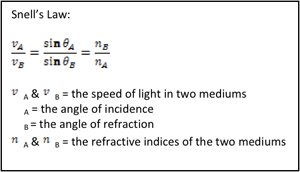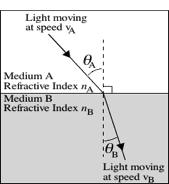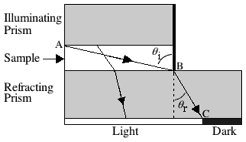Refractive Index Theory
What is a refractive index?
The refractive index is a ratio of the speed of light in a medium relative to its speed in a vacuum. This change in speed from one medium to another is what causes light rays to bend. This is because as light travels through another medium other than a vacuum, the atoms of that medium constantly absorb and reemit the particles of light, slowing down the speed light travels at. The refractive index ( ) can be calculated using the equation below.

However, it is also important to note that light changes direction when it travels from one medium to another. Therefore, another method to calculate the refractive index of a medium is to apply Snell’s law, which will be very important later in our discussion of refractometers.

The refractive index of any other medium is defined relative to the refractive index of a vacuum, which is assigned a value of 1. Thus, a refractive index of 1.33 for water means that light travels 1.33 times faster in a vacuum than in water.

Figure 1: The refraction of light. In this diagram, light travels faster in medium A than it does in medium B.
Refractive indices can be measured for different types of mediums including transparent or coloured solutions, turbid suspensions, emulsions, fine powders, ect.
Factors that affect the refractive index:
The two factors which affect the value of the refractive index are:
- Temperature
- Refractive index values are usually determined at standard temperature.
- A higher temperature means the liquid becomes less dense and less viscous, causing light to travel faster in the medium. This results in a smaller value for the refractive index due to a smaller ratio.
- A lower temperature means the liquid becomes denser and has a higher viscosity, causing light to travel slower in the medium. This results in a larger value for the refractive index due to a larger ratio.
- Refractometers usually have a means of temperature regulation.
- Wavelength of light
- The refractive index varies with wavelength linearly because different wavelengths interfere to different extents with the atoms of the medium.
- It is important to use monochromatic light to prevent dispersion of light into different colours.
- The chosen wavelength should not be absorbed by the medium.
- The sodium D line at 598 nm is the most frequently used wavelength of light for a refractometer.
Note: These two factors are present in the equation above,
where t = temperature in ºC and D = the wavelength of the light used in nm.
How is a refractive index measured?
A refractometer is used to measure the refractive index of a medium. There are many different types of refractometers, including the Abbe refractometer, which will be discussed in further detail below. A refractometer works based on the principle that light bends when it enters a different medium. This instrument measures the angle of refraction of light rays passing through the unknown sample. This measurement combined with the knowledge of the refractive index of the medium directly in contact with the unknown sample, are used to determine the refractive index of the unknown sample by applying Snell’s law described above.
The following cross sectional diagram illustrates the inner-workings of a refractometer. A light source shines on the illuminating prism and light rays enter the sample moving in different directions. The largest angle of incidence produced by a light ray (θi) produces the largest possible angle of refraction (θB). The other light rays entering the refracting prism all have a smaller refraction angle and lie to the left of point C. A detector at the back of the refracting prism produces the light and dark regions. In an Abbe refractometer, a detector is not present and there is more optics but the general scheme remains the same. Samples with different refractive indexes produce different angles of refraction which will cause a shift in the borderline between the light and dark regions. The borderline’s position is then used to establish the refractive index of different samples.

Figure 2: A cross-sectional diagram of part of the optical path of an Abbe refractometer. The sample thickness has been exaggerated for clarity.
Refractive Index Lab Procedures
 Anatomy of an Abbe 3L Bausch and Lomb refractometer (left and right view). |
|||
| 1. | Open prism assembly and remove lens tissue. Inspect the prism for cleanliness. If necessary, clean with water, methanol or acetone.
N.B. DO NOT WIPE DRY PRISMS WITH TISSUE. |
||
| 2. | Place liquid sample on the depression in the lower prism, using a pipette,
and close the prisms. Experience will show how much sample is necessary. Too much sample is messy,
while too little gives poor contrast for reading.
N.B. DO NOT ALLOW METAL OR GLASS APPLICATORS TO TOUCH THE PRISMS. |
||
Abbe 3L (Bausch and Lomb) |
AO Abbe Refractometer |
||
| 3. | Move the illuminator arm upwards. | Move the illuminator arm upwards. | |
| 4. | Turn the adjustment control until the lower field appears dark and the upper field light. | Turn the adjustment control until the lower field dark and the upper field light. | |
| 5. | Focus on the cross hairs by moving the eyepiece. | Turn the mode selector to nD. Focus on the cross hairs by moving the eyepiece. | |
| 6. | Rotate the dial for the Amici prisms until a sharp dividing line can be seen. There may be a tinge of red at one end of the line and a tinge of blue at the other. | Turn the Dispersion Correction Wheel until minimum colour is seen. Adjust the lamp for maximum contrast if necessary. | |
| 7. | Turn the adjustment controls to adjust the sharp dividing lines to precisely intersect with cross hairs. | Turn the adjustment controls to adjust the sharp line to precisely intersect with the cross hairs. | |
| 8. | Press contact switch at left side of instrument. Reading the top scale, estimating the 4th decimal place. | Depress READ button and record reading. | |
| 9. | Take a temperature reading from the attached thermometer. | Depress TEMP button and record reading. | |
| 10. | Clean the prisms by wiping off the sample with a lens tissue, followed by cleaning with methanol, acetone or water. | Clean the prisms by blotting off the bulk of the sample with a lens tissue, followed by cleaning with water, methanol or acetone. | |
| 11. | If you are the last student to use the instrument, make sure the prisms are clean and close them. Turn the instrument off. | ||
N.B. Temperature Correction
- Since refractive indices vary with temperature, for each degree Celsius of temperature change, the average temperature correction has been found to be 0.00045 units for a wide range of compounds.
- Ex. If the reading for the refractive index was 1.4370 at 18ºC, it would be corrected to 1.4370- 0.0009 = 1.4361 at 20ºC.
- Many refractometers have a theromometer and a means of circulating water to maintain a specific temperature.
Video:
This video illustrates step by step the usage of an Abbe 3L (Bausch and Lomb) refractometer.
http://www2.ups.edu/faculty/hanson/labtechniques/refractometry/operation.htm
Troubleshooting FAQs:
This is a good webpage for the most common problems when setting up your refractometer.
http://www2.ups.edu/faculty/hanson/labtechniques/refractometry/operation.htm
Why do we need to determine refractive indices?
Refractive indices have many purposes and are used most frequently to differentiate between liquid samples.
Therefore, this physical quantity characterizes liquids in the same way that melting points are used to
characterize solids. This measurement can serve as a means of identification of a substance by comparing
its refractive index to known literature values. Furthermore, refractive indices can be used to as an
estimate of the purity of a compound by comparing the substance’s refractive index to that of the pure compound.
In addition, refractive indices are also used to determine the concentration of a solute in a solution by comparing
the solution’s refractive index to a standard curve. Finally, refractive indices are influenced by the polarizability
of a medium. The more polarizable the material, the higher the refractive index is for the substance. Thus,
knowledge of the refractive index of a substance is also necessary to calculate dipole moments of that substance.
The molar refractions, R, can be calculated and are characteristic of that substance and indicative of its structure.